MERINOSELECT Research Indexes
Content:
- Redevelopment of SheepObject software
- Introducing the new MERINOSELECT research indexes
- Production system scenarios
- Comparison and selection advantages of the new indexes
A message from Sheep GeneticsDear Breeders We at Sheep Genetics are excited to be releasing the new MERINOSELECT research indexes as part of the results from the 21st June MERINOSELECT run. It is anticipated that these indexes will be available on the Sheep Genetics search site on the morning of the 1st July. This is the final update to be released as part of the 2023 Analysis Enhancements. For more information on this years enhancements visit www.sheepgenetics.org.au/ae23 The indexes have been in development since 2020/21 when the first round of industry consultation was undertaken. To ensure that the current and future needs of industry were met there was a comprehensive body of work undertaken to redevelop the software used to calculate indexes. This will not only benefit our MERINOSELECT indexes but will be used to develop indexes for our LAMBPLAN analyses in the future. Along with the redevelopment of the software the economic assumptions underpinning the indexes have also been updated to the latest price averages. The Research and Development work behind the Sheep Genetics indexes has been completed by the Animal Genetics and Breeding Unit (AGBU) and I’d like to personally acknowledge the contribution of Dr Sam Walkom and Professor Andrew Swan to the index development process. The work that has gone into the index software is world-leading and will allow enable targeted genetic gain towards current and future traits related to productivity and sustainability. The new MERINOSELECT indexes will be initially released as research indexes, which will be run in parallel with the existing Merino indexes until Analysis Enhancements 2024. Over the coming 12 months these indexes will be refined before replacing the old indexes in 2024. Sheep Genetics will be running a consultation process over this period to enable the industry to provide feedback on the new indexes. More information on how you can engage in this process will be shared in via Sheep Genetics communications over the coming month. Sheep Genetics have compiled documentation and fact sheets to assist you with understanding the new indexes. There are documents available for Ram breeders and Ram buyers as well as a document that delves into more detail on the selection advantages of each of the indexes. I would encourage everyone to look through these documents to assist in understanding these indexes and the trait responses from each. Please review these if you have any questions, alternatively you can contact one of the Sheep Genetics team. Finally thank you to everyone that has engaged in the index redevelopment process to-date. I’m excited to see these new indexes released to industry. Your Sincerely, Peta Bradley |
1. Redevelopment of SheepObject software
During the 2020/21 consultation period, it was identified that the current MERINOSELECT indexes required revision. Base price and production data used to inform indexes, as well as the inclusion of new emphasis traits (such as wrinkle, reproduction component traits, and condition score), were identified as focus areas from this review process.
As part of the redevelopment the SheepObject index system was completely revamped to greatly improve the modelling of production systems and cater for new traits. Key features include:
- Ability to value the component traits of reproduction separately, meaning breeders can now target rearing ability over increased litter size for example.
- Modelling the impacts of reproduction on lifetime wool production.
- Updated feed requirements accounting for weight gain, physiological status and wool growth.
- Variable feed costing throughout the annual production cycle, modelling seasonal pasture production and use of supplementary feeding where appropriate.
- Modelling the value of body condition as “feed saved” in returning ewes to joining condition following weight loss associated with pregnancy and rearing lambs, under Lifetime Ewe Management guidelines.
- Ability to accommodate a range of management strategies, for example the impact of culling dry ewes.
- Future-proofing the model to include feed efficiency and methane in indexes as data for these traits becomes available to underpin MERINOSELECT ASBVs.
Economic modelling within the software was also updated to 5-year averages from 2018 to 2023, with lamb and ewe dispersal prices provided by MLA and fleece values and premiums for fibre diameter and staple strength derived from AWEX price data. Current figures for labour, husbandry, and marketing costs are also used to ensure the model is realistic.
The redevelopment of the SheepObject software provides breeders with the ability to accurately reflect the modern Australian sheep production landscape. Indexes can now respond to new information in a timelier manner, and include traits under development, such as feed efficiency and methane.
2. Introducing the new MERINOSELECT research indexes
Based on the results of previous consultation, five indexes have been developed for the MERINOSELECT analysis. The below table summarises the indexes that will be released as research indexes (Table 1).
Table 1: MERINOSELECT research indexes. The dots depict the level of importance for the trait in each of the indexes
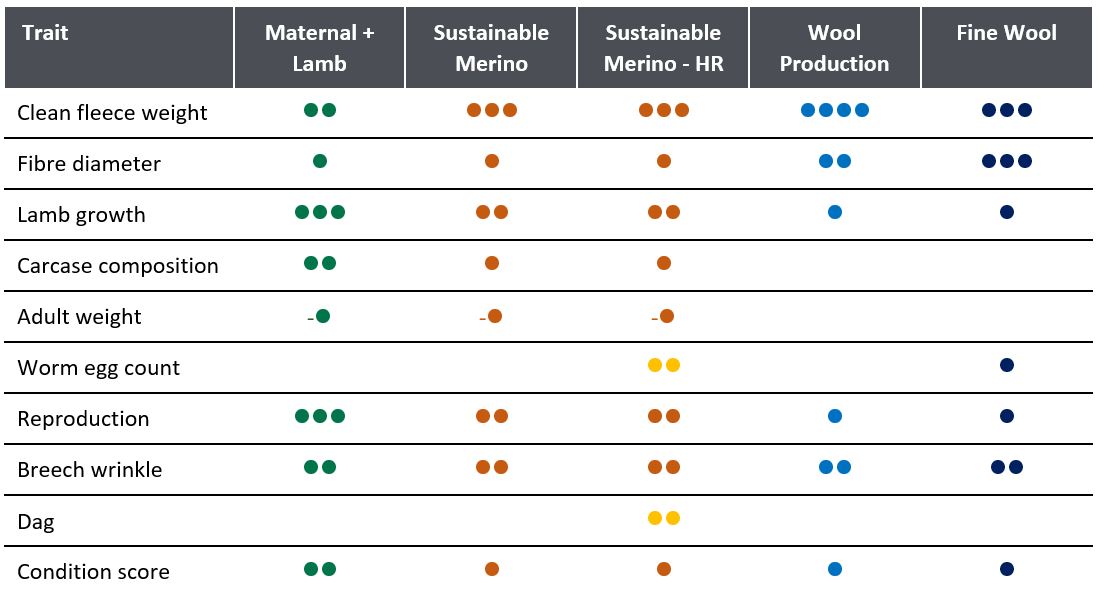
Please note, the negative symbol associated with the Adult Weight trait in the above table is an indication that bigger ewes incur higher feed costs, and there is a trade-off that bigger ewes also produce more lambs which reach sale weight faster. In other words, the indexes aim to increase reproduction and lamb growth while limiting increases in mature size.
3. Production system scenarios
Within these indexes there are four key production systems modelled (the SM and SMHR indexes modelled from the same production system). Across the systems there are some key constants. These include:
- labour costs
- husbandry costs
- managing ewes to meet the lifetime wool guidelines
- adult ewe culling rates
- flock structure
However, there are key differences between these production systems. These are shown in Table 2.
Table 2. Production system scenarios used in SheepObject to estimate economic values.
|
Trait |
Maternal + Lamb (ML) |
Sustainable Merino (SM/SMHR) |
Wool Production (WP) |
Fine Wool (FW) |
|
Production System |
||||
|
Flock structure |
First lamb as 2-year-old and joined 5 times |
First lamb as 2-year-old and joined 5 times |
First lamb as 2-year-old and joined 5 times |
First lamb as 2-year-old and joined 5 times |
|
Lamb marketing strategy |
Older age class ewes joined to a terminal sire |
Merino wethers sold post-weaning off shears |
Merino wethers sold after hogget shearing |
Merino wethers sold after hogget shearing |
|
Feed costs |
Higher |
Standard |
Standard |
Standard |
|
Culling of breeding ewes |
Dry ewes culled / 10% visual cull / 3% ewe mortality |
Dry ewes culled / 10% visual cull / 3% ewe mortality |
Dry ewes culled / 10% visual cull / 3% ewe mortality |
Dry ewes culled / 10% visual cull / 3% ewe mortality |
|
Wool Assumptions |
||||
|
Greasy fleece weight |
5.5 kg |
6.0 kg |
6.5 kg |
5.0 kg |
|
Fibre diameter |
20 micron |
19 micron |
18 micron |
16 micron |
|
Staple Strength |
32 nkt |
30 nkt |
30 nkt |
32 nkt |
|
Weight Assumptions |
||||
|
Standard reference weight |
70 kg (80 kg for terminal joining) |
65 kg |
60 kg |
55 kg |
|
Reproduction Assumptions |
||||
|
Conception* |
0.92 |
0.90 |
0.88 |
0.85 |
|
Litter size* |
1.60 |
1.50 |
1.40 |
1.30 |
|
Ewe rearing ability (single/twin/triplet)* |
0.90/0.80/0.60 |
0.90/0.78/0.58 |
0.85/0.75/0.55 |
0.83/0.73/0.53 |
|
Weaning rate* |
1.28 |
1.15 |
0.98 |
0.85 |
|
Ratio of Wool to Meat income |
35:65 |
46:54 |
55:45 |
65:35 |
*Units for reproduction assumptions:
Conception: Proportion of ewes pregnant to ewes joined
Litter size: Proportion of foetuses to ewes pregnant
Ewe rearing ability (split by litter category – single, twins and triplets): Proportion of lambs reared to lambs born, split into litter category
Weaning rate: Proportion of lambs weaned to ewes joined
Traits included within the indexes:
- Key profit drivers of fleece weight, fibre diameter and staple strength
- Micron premiums were based on the wool prices over the last 5 years, however are adjusted to achieve a balanced response across traits in the indexes.
- new methodology developed to value staple strength.
- Growth is reflected by post weaning and lean meat yield in the ML, SM, SMHR and WP indexes.
- Adult ewe weight in all the indexes with an increased weight having a negative impact on profit due to additional feed costs.
- Inclusion of adult ewe condition score with an economic value included in all indexes and greater emphasis in the ML index.
- Inclusion of the component traits for reproduction: conception, litter size and ewe rearing ability.
- Traits associated with disease and production costs, such as emphasis on reducing breech wrinkle, worm egg count and the addition of dag in the SMHR.
The new indexes combine the traditional production output traits and the new traits viewed as important by industry of condition score, lamb carcase, production components, and welfare traits into the modern Australian breeding objective.
4. Comparison and selection advantages of the new indexes
The selection decisions and genetic gain made by industry on the existing indexes has not been wrong. These indexes have seen great levels of genetic gain in the Australian sheep industry for important production traits. The new indexes are building on this success seen by breeders, and adding focus on newer traits that are of growing importance to industry.
The information below discusses the new research indexes, grouping them based on their similarities to the existing MERINOSELECT index production systems. The comparison includes the relative economic contribution of each trait group within the indexes.
Please note that a negative relative contribution refers to traits where a lower breeding value for that trait is more desirable. For example, the more desirable direction for wrinkle is to decrease, therefore higher wrinkle levels have a negative economic contribution.
For current FP+ users
- The existing Fibre Production Plus (FP+) index was based on self-replacing Merino flock where majority of income is from the wool clip. There was specific focus on wool quality, reducing fibre diameter, increasing staple length, and reducing worm egg count.
- Current FP+ users are likely to lean towards the Wool Production (WP) or Fine Wool (FW) research indexes.
The Fine Wool (FW) aligns the closest with the FP+ index however there is greater weighting on reducing wrinkle and improving reproduction via ewe rearing ability in the FW index.
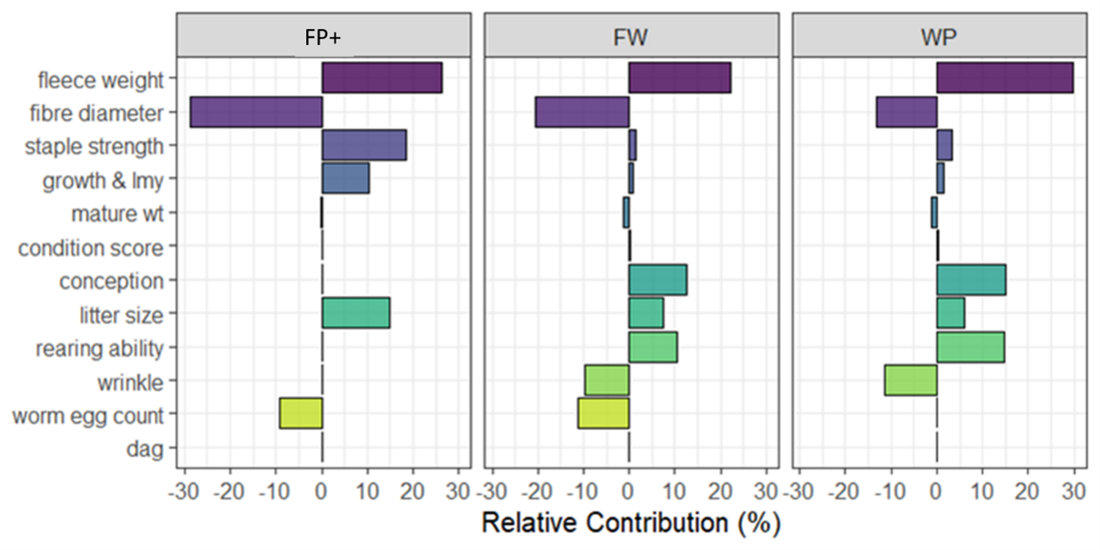
Figure 1: Relative economic weighting of trait groups within Fibre Production Plus (FP+) compared to the research indexes, Fine Wool (FW) and Wool Production (WP).

Figure 2: Comparison of index values for the sires of 2021 progeny from MERINOSELECT for Fibre Production Plus (FP+) against the research indexes, Fine Wool (FW) and Wool Production (WP).
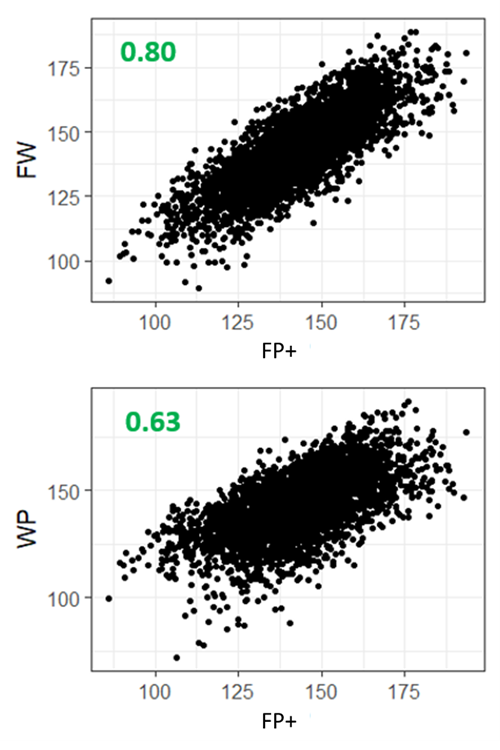
Figure 3: Correlation between FP+ to FW and WP index value across the sires represented by green number.
For current MP+ index users
- The existing Merino Production Plus (MP+) index was based on self-replacing Merino flock where income is a combination of wool and surplus sheep sales. There was a focus on increasing fleece weight and reducing fibre diameter, increasing or maintaining staple strength and selling surplus animals as yearlings.
- Current MP+ users are likely to lean towards the Wool Production (WP), Sustainable Merino (SM), or Sustainable Merino High Rainfall (SMHR) research indexes.
- The difference between these research indexes will be determined on the individual breeders focus on traits such as worm egg count, dag and the level of emphasis on wool vs lamb production. All three indexes have a focus on reducing wrinkle and a balanced response to reproduction through emphasis on the component traits.
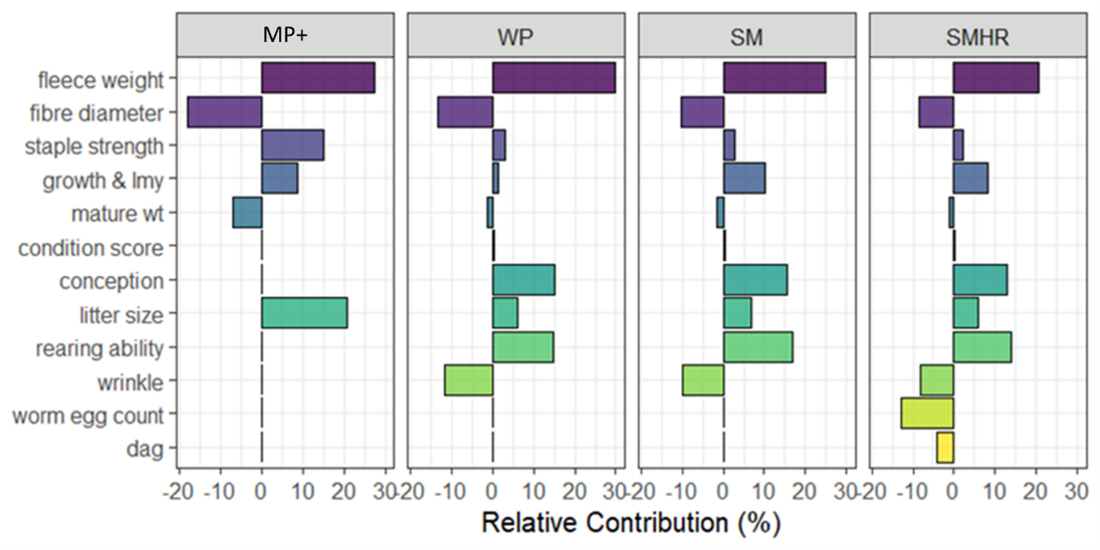
Figure 4: Relative economic weighting of trait groups within Merino Production Plus (MP+) compared to the research indexes, Wool Production (WP), Sustainable Merino (SM) and Sustainable Merino High Rainfall (SMHR).
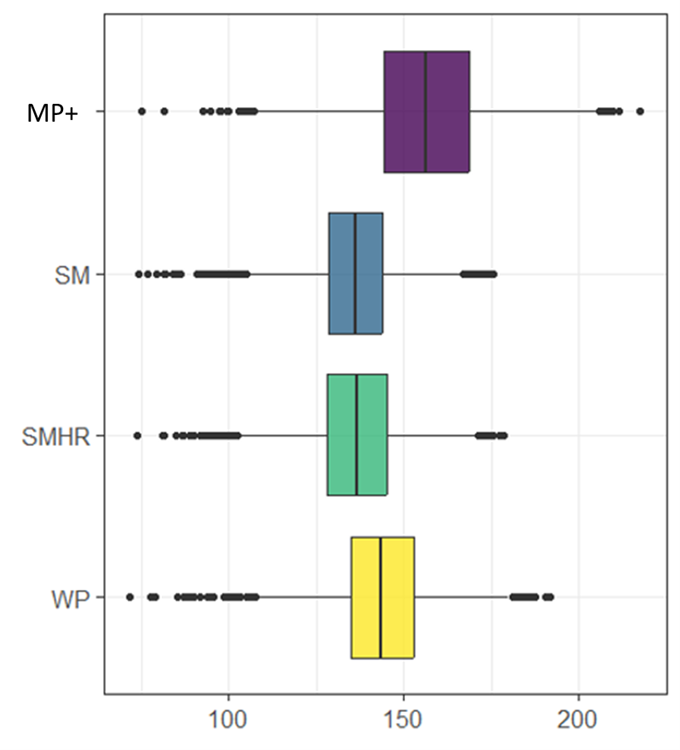
Figure 5: Comparison of index values for the sires of 2021 progeny from MERINOSELECT for Merino Production Plus (MP+) against the research indexes, Wool Production (WP), Sustainable Merino (SM) and Sustainable Merino High Rainfall (SMHR).
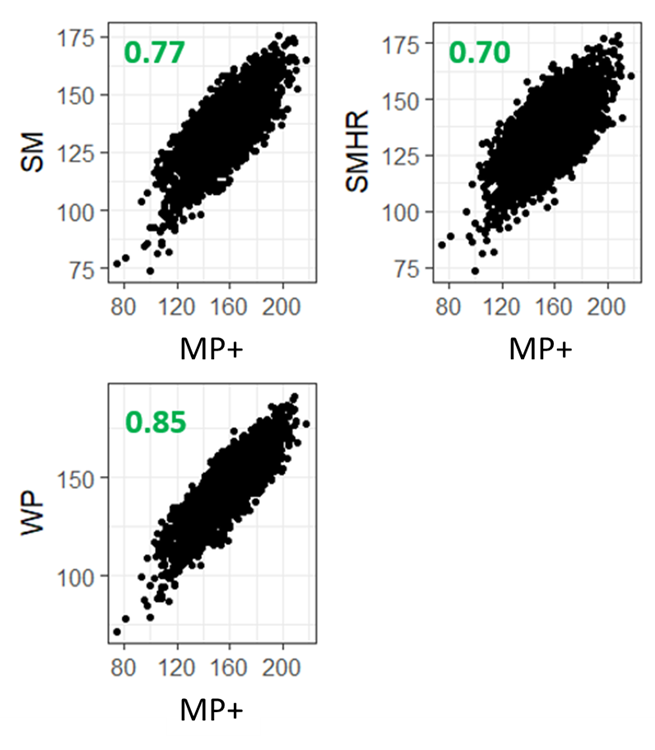
Figure 6: Correlation between MP+ and relevant research index value across the sires represented by green number.
For current DP+ index users
- The Dual Purpose Plus (DP+) was based on self-replacing Merino flock with a greater focus on lamb production and a proportion of the ewe flock mated to a terminal sire to generate crossbred lambs. This index included greater emphasis on growth, carcase performance and reproduction than other existing indexes.
- Current DP+ users are likely to lean towards the Sustainable Merino (SM) or Maternal Lamb (ML) research indexes.
- The main differences between Sustainable Merino (SM) and Maternal Lamb (ML) research indexes are increased selection advantage for wool production and quality in SM compared to an increased selection advantage for growth in the ML index.
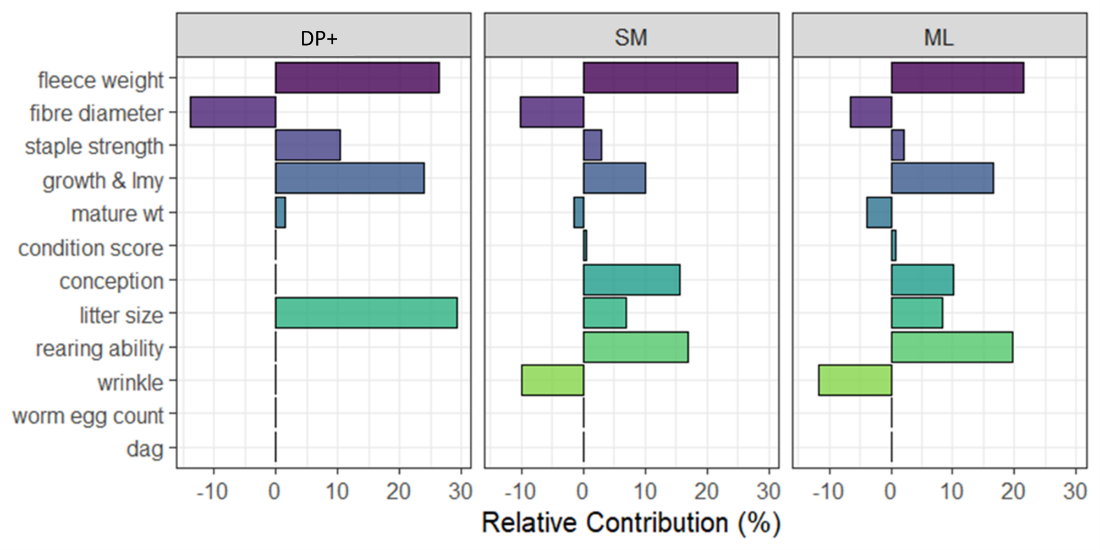
Figure 7: Relative economic weighting of trait groups within Dual Purpose Plus (DP+) compared to the research indexes, Sustainable Merino (SM) and Maternal plus Lamb (ML).
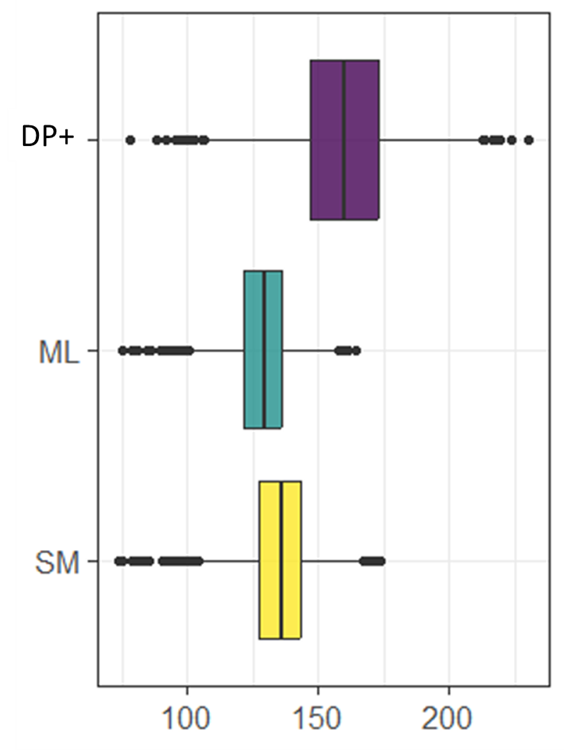
Figure 8: Comparison of index values for the sires of 2021 progeny from MERINOSELECT for Dual Purpose Plus (DP+) against the research indexes, Sustainable Merino (SM) and Maternal plus Lamb (ML).
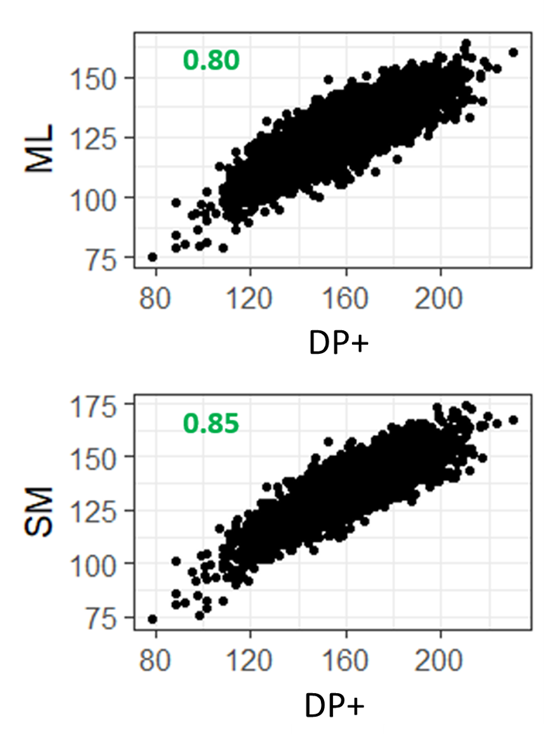
Figure 9: Correlation between DP+ and relevant research index value across the sires represented by green number.
Acknowledgement
Sheep Genetics would like to acknowledge the R&D work behind the Sheep Genetics evaluations and these new indexes completed by the Animal Genetics and Breeding Unit (AGBU), funded by Meat and Livestock Australia (MLA).